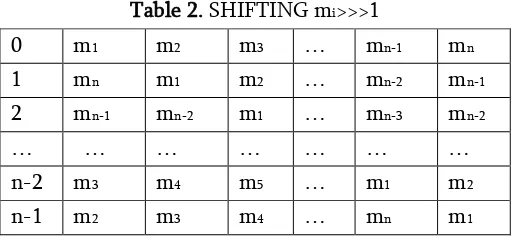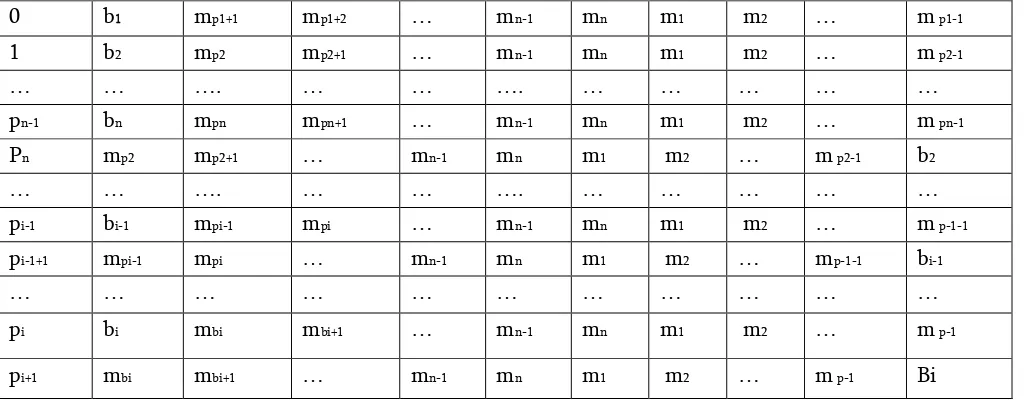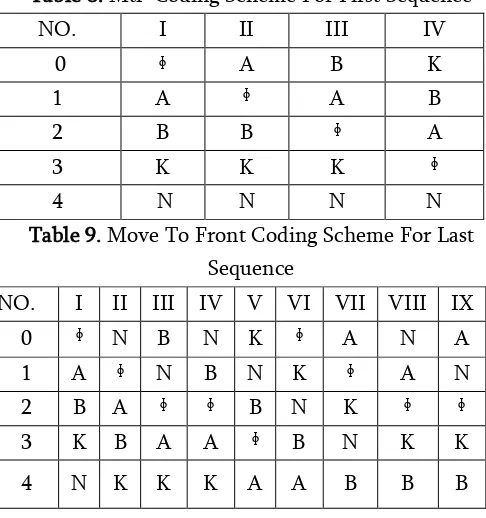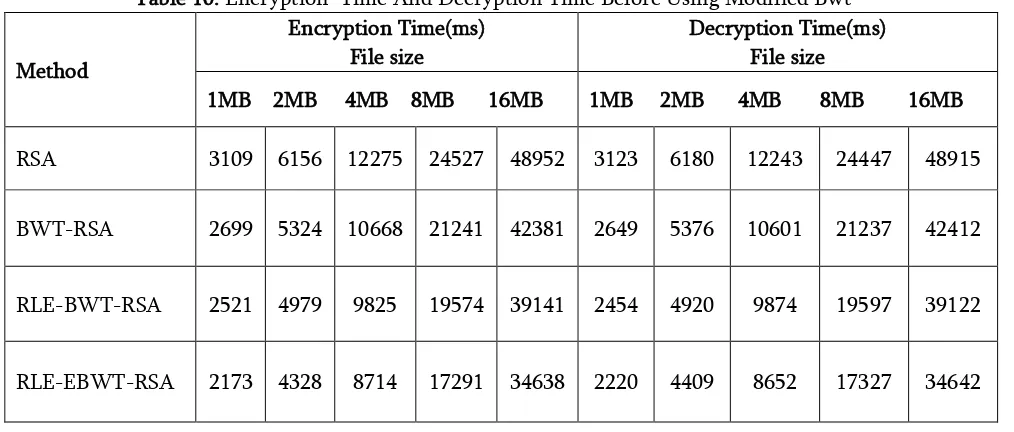CSEIT1831152 | Received : 15 Jan 2018 | Accepted : 03 Feb 2018 | January-February-2018 [(3) 1 : 687-696 ]
International Journal of Scientific Research in Computer Science, Engineering and Information Technology © 2018 IJSRCSEIT | Volume 3 | Issue 1 | ISSN : 2456-3307
687
Enhancing Security in RSA Cryptosystem Using
Burrows-Wheeler Transformation and Run Length Encoding
A. Devi*1, K. Mani2
*1Department of Computer Science, Bangalore University/KCMS College, Bangalore, Karnataka State, India 2Department of ComputerScience, BharathidasanUniversity/NMC, Thiruchirapalli, Tamil Nadu State, India
ABSTRACT
While transmitting the plaintext, to speed up the transmission and eliminating redundancy, it is necessary to compress the text. As the original form of plaintext is altered when compression is used, the eavesdropper may not easily be cracked the correct plaintext which produces first level of security. Once the compression has been done, encoding is performed to form the different format so that fewer bits will be used to represent the original plaintext thereby size of the original text is reduced which produces the second level of security. For that the Burrows-Wheeler Transform lossless compression technique is used in this paper to transform the plaintext and the transformation permutes the order of characters. To reduce the redundancy and to increase the efficiency of algorithm, move-to-front transformation is performed in BWT. Further, the transformed code is again compressed using run length encoding and then it is encrypted using RSA public-key algorithm in which block size is determined dynamically in this paper. The experimental results clearly show that the increasing of encryption and decryption time and enhancing the security of RSA.
Keywords: BWT, Move-to-Front, Run-Length Encoding, RSA.
I.
INTRODUCTION
Encryption ensures security to access confidential data by an authorized recipient and avoid accessing the data from third party. Encryption is used to protect data when transmitting the data across networks against eavesdropping of network traffic by unauthorized users [12]. It is also used to protect sensitive information by encoding and transforming the information into an unreadable ciphertext and the ciphertext may be decrypted into a readable form using key. Secret-key and public-key cryptography[13] are the two types of cryptosystems in which secret-key cryptography uses the same key for both encryption and decryption whereas in public-key cryptography, secret-key and public-key is used by each user. The public-key is used for encryption and the secret-key is used for decryption.
The most popular public-key algorithm is RSA public-key cryptosystem. The design of a robust encryption algorithm in cryptanalysis is used to find and correct any weaknesses [11]. Encryption provides only security but not increasing the transmission speed [9]. To increase the speed, the data compression technique is efficient to remove the redundant character strings in a file in which the compressed file has uniform distribution of characters and it provides shorter ciphertext. It also reduces the time to encrypt and decrypt the message.
is also a fixed model. An adaptive model is a function of previously compressed part of the data. The Burrows-Wheeler transformation [8] developed by Michael Burrows and David Wheeler in 1983, also called as block sorting and it is based on a permutation of the input sequence. Compression and indexing are the two important applications in BWT. In [10] BWT, first the entire sequence is to be coded. For that the original sequence must be cyclically shifted from right to left and arranged in the form of lexicographic order. Then, the sequence is converted into binary and Run-Length Encoding (RLE) is applied to increase the security level in RSA algorithm. The compressed code is applied for RSA public-key algorithm to encrypt the code.
The rest of the paper is organized as follows. Background and related work is discussed in section 2. Section 3 presents the proposed methodology in BWT with Move To Front (mtf). An example for proposed methodology is illustrated in section 4. Experimental results are discussed in section 5. Finally, section 6 ends with conclusion.
II.
BACKGROUND AND RELATED WORK
Data Compression Methodologies for Lossless Data and Comparison between Algorithms presented by S.Porwal, Y.Chaudhary, J.Joshi, M. Jain[1]. They compared the performance of Huffman and Arithmetic encoding. After comparison of two techniques they concluded that the compression ratio for arithmetic encoding is better than the Huffman encoding and also found that the channel bandwidth and time is reduced much better than Huffman encoding. But the compression speed is very less in arithmetic encoding than the Huffman coding. U.Khurana and A.Koul[2] provides Text Compression And Superfast searching and they proved that it is an efficient technique providing high compression ratios and faster search through the text. S.Kaur and V.S.Verma[3] implemented a Design and Implementation of LZW Data Compression Algorithm. The author has
implemented a finite state machine by using LZW data compression algorithm and he proved that text data is effectively compressed. A Data Compression using Huffman based LZW Encoding Technique is presented by Md.RubaiyatHasan[4] for transmitting a digital image from a digital data source to a digital data receiver. The author has proved that it provides better transmission speed and saves time. Rajan.S.Jamgekar et.al[5] implemented a File Encryption and Decryption Using Secure RSA. It shows that MREA algorithm is used to encrypt files and transmit encrypted files to other end where it is decrypted. But it works for smaller file size whereas it takes more time for larger file size. In [6], Monisha Sharma et.al described about a novel Approach of Image Encryption and Decryption by using partition and Scanning Pattern. The author has proposed a lossless encryption of image and also gives access to variable lengths of the encryption keys.
III.
PROPOSED METHODOLOGY
The proposed methodology consists of three phases. In phase 1, the proposed mtf-BWT is used in performing the compression of plaintext. RLE is used in phase 2 for further compression of compressed text obtained in phase 1. Then, the decimal form of binary encoded compressed form of plaintext is encrypted using dynamically generated block size of RSA in phase 3.
3.1 Proposed MTF-BWT
This phase consist of three steps viz., Shifting of plaintext characters towards left circularly, arrange them in lexicographic order and formation of move to first(mtf) .
3.1.1 Shifting Of Plaintext Characters Towards Left Let M be a plaintext, and mi M, i=1,2,3,…,n where n
denotes the total number characters in M( length of M). Suppose there are totally d distinct characters denoted as m1,m2,..,md with m1≠m2≠…≠md in M and
there are n1,n2,…,nd times distinct charactersoccur
∑
Fill mi M in tabular form and shift one position
towards left circularly as shown in Table 1.
Table 1. ORIGINAL MESSAGE mi<<<1 , i-1,2,…,n
0 m1 m2 m3 … mn-1 mn shift circularly shown in Table 2.
Table 2. SHIFTING mi>>>1
0 m1 m2 m3 … mn-1 mn
position towards right circularly. In row 0 of Table 2 consists of original M. Shift one position towards right circularly all the elements in 0th row so that
row 1 is obtained. In general (n-1)th row is obtained
by shifting each element of (n-2)th row one position
towards circular right. The steps involved in algorithm1 show that the order of sequence will be different from original BWT.
Algorithm 1: Circular shifting of plaintext characters towards right
3.1.2 Arrange Them In Lexicographic Order
After forming Table 2, sort the Table 2 in lexicographical order. For that first identify the number of blank spaces bk in M. If the number of
blank space occurs in M is k, then the number of words in M is k+1. Let the blank spaces are denoted as b1,b2,…,bk and the blank spaces bi
position pi, i=1,2,…,k. After that identify the
distinct alphabets where d≤ n from M which is
shown in algorithm 2 and sort them in ascending order.
end {main}
Let the alphabet al occurs at position lk, k=1, 2,…,d
with pi≠lk. Further, a1<a2<…<ad. Now start with b1 at
p1, put all the characters that appear after b1, proceed
up to the last character before b1 occurs at position
p1-1and fill them in 0th row of Table 3.
Table 3. Lexicographical Order
Similarly, start with b1, proceed up to the position p2-1,
fill the corresponding characters in 1st row. Repeat the
said process for other blank spaces too and the process in terminated when the last bk is processed. Once all bk
are processed now start with al and repeat the said
process till ad are processed. It is shown in Table 3 and
it is shown in algorithm 3.
Algorithm3: Forming the source character in Lexicographical Order
String Lexi Function Lexicographic(M) begin {main}
1. posa←distinct(M) 2. l←length(posa) 3. k←1
4. for i in 1 to l begin
4.1 st←posa[i]+1
4.2 st←posa[i]+1 end{for i}
5. if st ≤ end k←k+1 lex[k] ←M[st] st←st+1 end {if}
6. for j=1 to posa[i]-1 begin
6.1 k←k+1 6.2 lex[k] ←M[j] end{for j}
7. Loop←1 8. for m←1 to l
begin
8.1 x[Loop][m] ←lex[m]
8.2 Loop←Loop+1 end {for m]
9. return x[Loop][m] end {main}
The main difference between the existing and proposed methodology is that in the proposed methodology, first sequence is always considered for mtf whereas in the existing methodology the last sequence is considered.
Form a table with order nr x nd, Where nr ≥ nd and nr is determined on the basis of first sequence of lexicographical order. The source alphabet is {n,m,m,…,m }. To fill the value in row 1, the top 0 b1 mp1+1 mp1+2 … mn-1 mn m1 m2 … m p1-1
1 b2 mp2 mp2+1 … mn-1 mn m1 m2 … m p2-1
… … …. … … …. … … … … …
pn-1 bn mpn mpn+1 … mn-1 mn m1 m2 … m pn-1
Pn mp2 mp2+1 … mn-1 mn m1 m2 … m p2-1 b2
… … …. … … …. … … … … …
pi-1 bi-1 mpi-1 mpi … mn-1 mn m1 m2 … m p-1-1
pi-1+1 mpi-1 mpi … mn-1 mn m1 m2 … mp-1-1 bi-1
… … … …
pi bi mbi mbi+1 … mn-1 mn m1 m2 … m p-1
position of (0, 0) must be filled by b1 (the first blank
space) and the succeeding columns in rows r1 are
filled with other alphabets from source alphabet. Search the position of first alphabet in the previous row and move the element from that position to the top position, i.e., (1, 0) and fill the rest of the alphabet in the succeeding position. The process is repeated until all the n distinct elements are filled from the source sequence. In order to determine the final sequence, the elements must be considered from the moving position of previous row to the top position in the same row. Now, the final sequence is represented as n1, n2, n3,…,nn. It is noted that the
number of characters in final sequence stored as same. It is shown in algorithm 4.
Algorithm4: For finding the move to front String FS move-to-front(mtf)
4.1 if k=dsp[j] and k<length(dsp) then begin repeating string of characters. The repeating string is called run. It replaces sequences of the same data values within a file by a count number and a single value. For example, the bit stream ,
11111111111111100000000000000000001111 is compressed using RLE as 15119041. In the proposed method, mtf based BWT and RLE are used before encryption. For performing encryption and decryption, the standard RSA is used and the proposed methodology is now termed as RLE-EBWT-RSA.
3.3 RLE-EBWT-RSA
In original RSA, the block size taken is either 2048 or 4096 bits and it is always constant. In the modified RSA block size is determined on the basis of modulus m, m= p×q and it depends on the size of p and q where p and q are prime numbers. As p and q are accepted as input, the block size is based on only m and the block size denoted as BS is unpredictable which produces the first level of security. Further, original P is completely changed using the proposed methodology before it is encrypted the eavesdropper may not predict the correct P from C which increases second level of security. The steps involved in modified RSA algorithm are shown in algorithm 5.
Algorithm 5: Modified RSA algorithm based on mtf based BWT
int IP function modified_RSA(M) begin {main}
// Te first 6 steps for key generation part, step 7 is //generating IP after using the proposed
methodology. 8th step is performed by the sender and
9th is performed by receiver
Locate i digits from IP, say IPi
After getting IP by the receiver the steps from 3.1 to 3.3 are reversed, the receiver gets the original plaintext.
IV.
PROPOSED METHODOLOGY – AN
EXAMPLE
position towards left circularly. The process is repeated for the last character “A” in M. It is shown Table 4. fill the next row of table 5 shifting towards circularly right row 0 so that row 1 is obtained. In row 1, now the next alphabet in sorted order is B. Start with B fills
all the characters which occur in row 1 by shifting towards right circularly. The process is repeated until the last character “N” is processed. The resultant is lexicographical order shown in table 6. Table 6, consists of the cyclically shifted sequences which are in the lexicographical order.
Table 6. Lexicographic Order For Modified Bwt 0 ᶲ B A B A K A N N A N
Table 7. First And Last Sequence Of Elements Fi ᶲ A A A A B B K N N N
Li N B B N K ᶲ A A A N A
i- Element of First and Last sequence
last sequence L is considered for mtf. But, in the proposed methodology, the first sequence F is considered so that the number of moving position of the each element to the 0th position is very less. This
is because F gets the repeated element several times. The source alphabet A based on F is { ᶲ,A,B,K,N }. In this coding scheme, the first element is blank space which is already in the top position and there is no change in the position. Thus, 0 is placed in the sequence. The second element is A from the sequence moving from first position into the top of the list. This is encoded as 1.The next subsequent three elements from sequence are A and hence it is not necessary to encode the those elements instead and three zeros in the sequence. The next element is B moving towards the top of the list from second position and it is encoded as 2. Again B is repeated and it is considered as zero. After B, the element K is moving towards the top of the list and it is encoded as 3.The last three elements from the sequence is N which is moving towards the top of the list from the position four and it is encoded as 4.The two elements out of three are zeros. The final sequence from this coding scheme is 01000203400. The mtf for first sequence and last sequence are shown in Table 8 and Table 9 respectively.
Table 8. Mtf Coding Scheme For First Sequence NO. I II III IV
0 ᶲ A B K
1 A ᶲ A B
2 B B ᶲ A
3 K K K ᶲ
4 N N N N
Table 9. Move To Front Coding Scheme For Last Sequence
NO. I II III IV V VI VII VIII IX 0 ᶲ N B N K ᶲ A N A 1 A ᶲ N B N K ᶲ A N 2 B A ᶲ ᶲ B N K ᶲ ᶲ 3 K B A A ᶲ B N K K
4 N K K K A A B B B
The first sequence is “ᶲAAAABBKNNN“. Once the mtf for the first sequence is 01000203400. After applying RLE, it is compressed as 0130203420. It is treated as IP plaintext for encryption. Similarly, the last sequence is “NBBNKᶲAAANA” and its mtf is 43014340031 and its compressed form is 4301433201. It is observed that the number of digits are more in last sequence than the number digits in first sequence. To perform encryption and decryption using modified RSA, let p=50053 and q=50069. Then n=2506103657, ф(n)= 2506003536, (n)2=1001 0101 0110 0000 0001
1011 0110 1001. Thus, block size BS=32 bits. Let e= 56989. Using Extended Euclidean Algorithm d is computed as 2472671653. Let M=”KANNAN BABA”. Using the proposed methodology IP1(M) =0130203420
where the number of bits for IP=27. As 27< 32, BS=1. To encrypt C1 =(130203420)56989 mod 2506103657
=638232499 and to decrypt IP1=(638232499)2472671653
mod 2506103657=130203420. After obtaining IP, the reverse process, i.e., decompression and decoding are performed to get M=”KANNAN BABA”.
V.
RESULTS AND DISCUSSIONS
Figure 1. Encryption Time Before Modified BWT
Figure 2. Decryption Time Before Modified BWT
The encryption time and decryption time for RSA algorithm after using modified BWT is analyzed for various sizes of plaintext. The encryption time and decryption time of 1MB file size is 3109 and 3133.The encryption and decryption time for 16 MB is 48957 and 48925. After applying BWT encoding with RSA algorithm, the encryption and the decryption time for 1MB and 16 MB are 2699,42386 and 2659,42422. After applying the compression using RLE-BWT with RSA, the encryption and
decryption time varies from 39155 to 39127 for 16MB. For RLE with enhanced BWT-RSA, the encryption time and the decryption time lies between 34652 and 34647 of 16MB file size of plaintext as shown in table 11. The experimental results clearly show that RLE-EBWT-RSA outperforms than the other counterpart.
Figure 3. Encryption Time After Modified BWT with mtf
Figure 4. Decryption Time After Modified BWT with mtf
Table 10. Encryption Time And Decryption Time Before Using Modified Bwt
Method
Encryption Time(ms) File size
Decryption Time(ms) File size
1MB 2MB 4MB 8MB 16MB 1MB 2MB 4MB 8MB 16MB
RSA 3109 6156 12275 24527 48952 3123 6180 12243 24447 48915
BWT-RSA 2699 5324 10668 21241 42381 2649 5376 10601 21237 42412
RLE-BWT-RSA 2521 4979 9825 19574 39141 2454 4920 9874 19597 39122
Table 11. Encryption Time And Decryption Time After Using Modified Bwt
Method
Encryption Time(ms) File Size
Decryption Time(ms) File Size
1MB 2MB 4MB 8MB 16MB 1MB 2MB 4MB 8MB 16MB
RSA 3109 6168 12277 24528 48957 3133 6190 12247 24451 48925
BWT-RSA 2699 5336 10670 21242 42386 2659 5386 10605 21241 42422
RLE-BWT-RSA 2531 4981 9829 19586 39155 2466 4924 9879 19600 39127
RLE-EBWT-RSA 2183 4330 8718 17303 34652 2232 4413 8657 17330 34647 The compression ratios are shown in Table 12 and the corresponding graphical representation is shown in Figure 5.
Table 12. Compression Ratio
Method
Compression Ratio(%) File size
1MB 2MB 4MB 8MB 16MB RSA 100 100 100 100 100 BWT-RSA 100 100 100 100 100
RLE-BWT-RSA 84 88 88 88 86
RLE-EBWT-RSA 83 87 87 87 85
Figure 5. Compression Ratio
Table 13 shows the security level for various existing and proposed algorithms. Because of run length encoding is applied after encoding using BWT and the first sequence is considered for mtf in BWT rather than last sequence ,the security level of RLE-EBWT-RSA is increased upto 93% for 16MB compared to RLE-BWT-RSA with 90%. The various levels of security is shown in figure 6.
Figure 6. Security Level
Table 13. Security Level
Method
Security Level(%) File Size
1MB 2MB 4MB 8MB 16MB RSA 84 85 85 82 78
BWT-RSA 95 93 90 89 90
RLE-BWT-RSA 95 94 94 91 90
RLE-EBWT-RSA 96 96 95 94 93
VI.
CONCLUSION
algorithms. Further, the block size is determined dynamically only on the basis of modulus m, which enhances the security as opposed to block size is fixed like 2048 or 4098 bits normally used in well known standard RSA public-key cryptosystems. The experimental results strengthen the increasing the speed and enhancing the security level using the proposed methodology.
VII.
REFERENCES
[1]. S.Porwal, Y.Chaudhary, J.Joshi, M. Jain, "Data Compression Methodologies for Lossless Data and Comparison between Algorithms", International Journal of Engineering Science and Innovative Technology (IJESIT) ,Vol.2, Issue 2, March 2013.
[2]. U.Khurana and A.Koul, "Text Compression and Superfast Searching", Thapar Institute Of Engineering and Technology, Patiala, Punjab, India-147004.
[3]. S.Kaur and V.S.Verma, "Design and Implementation of LZW Data Compression Algorithm", International Journal of Information Sciences and Techniques (IJIST) Vol.2, No.4, July 2012.
[4]. Md.RubaiyatHasan, "Data Compression using Huffman based LZW Encoding Technique", International Journal of Scientific & Engineering Research Vol.2, Issue 11, November-2011.
[5]. Rajan.S.Jamgekar, Geeta Shantanu Joshi, "File Encryption and Decryption Using Secure RSA", International Journal of Emerging Science and Engineering (IJESE), Vol-1, Issue-4, February 2013.
[6]. Monisha Sharma, Chandrashekhar Kamargaonkar, Amit Gupta, "A Novel Approach of Image Encryption and Decryption by using partition and Scanning Pattern", International Journal of Engineering Research & Technology (IJERT), Vol. 1, Issue 7, September- 2012.
[7]. https://en.wikipedia.org/wiki/Data_compressio n
[8]. D. Adjeroh, T. Bell, and A. Mukherjee, "The Burrows-Wheeler Transform: Data Compression, Suffix Arrays, and Pattern Matching", Springer, 1 edition, July 2008. [9]. K.Mani and A.Devi, "Enhancing Security in
Cryptographic Algorithms Based on IENCCRS Scheme", IJAER,Vol.10, No.82, 2015.
[10]. J.Seward,"On the performance of bwt sorting algorithms", In Data Compression Conference, pages 173–182, IEEE Computer Society, 2000. [11]. https://en.wikipedia.org/wiki/Elgamal.
[12]. William Stallings ,"Cryptography and Network Security, Principles and Practices", Fourth Edition , November, 2005.




